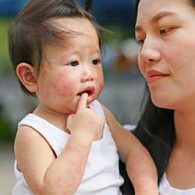Chicken Skin: Ways to Treat Keratosis Pilaris
Do you have any advice for chicken skin on a toddler? I have tried to eliminate so many different foods from my daughters diet but it will not go away. Is this just something we have to deal with ?
Answer:
“Chicken skin” in dermatological speak is called keratosis pilaris and is a common and harmless skin irritation that can occur at all ages. It is caused by the build-up of a natural pigment in the skin, keratin, which collects around hair follicles. My first psychological tip is if it doesn’t bother your child try not to let it bother you. This is especially true of over focusing on “chicken skin” in a sensitive teenager. I have spent many hours putting various lotions and potions on our children’s chicken skin and here’s what I’ve learned:
Nourish From the Inside Out
First, treat dry or irritated skin not only from the outside (what you put on it) but first from the inside (what you put into it), and that means how you nourish the skin by what you eat and drink. The top skin-friendly nutrient is omega-3 fats found in seafood. Next time you get a fresh piece of salmon, rub your hand along the oily surface to appreciate how skin loves fats. The omega-3 fats in seafood have two properties the skin loves: they are anti-inflammatory (meaning they keep the skin from getting rough and itchy) and they also moisturize the skin.
The omega-3 fat molecule is called a “flexible fat”. When it gets into the skin it causes skin tissue to be flexible. (If you want to learn more about how omega-3s are so good for the skin, see our book, The Omega-3 Effect, written by Dr. Bill and our son, Dr. Jim). Feed your child two of her fistfuls of wild salmon every week and give her an omega-3 supplement of around 200 milligrams a day. That is the best inside nutrient you can feed your child. Also, hydrate the skin from the inside. Encourage her to drink around an ounce of water per pound of her body weight per day.
Outside Treatment
Now for the outside treatment. One of the easiest and most effective treatments I used on our children’s dry and rough skin was what I called “soak and seal.” After their bath or shower, instead of vigorously rubbing them completely dry I would gently blot the wet skin over the rashy areas and leave a thin layer of water remaining. Then I would cover it with, at the time my favorite emollient, Lansinoh – a lanolin-rich ointment that mothers use for sore and dry nipples.
A layer of ointment over the water layer on the skin keeps the skin moisturized during the night. It helps them wake up with less of a rash in that area. There are also other over-the-counter emollients and moisturizers you can try. Also, massaging in a thin layer of coconut oil over the irritated skin may help.
Additional Recommendations
“Chicken skin” is usually worse in the wintertime because of the dry, warm air. That’s when moisturizing the skin at night before bedtime really helps. And, you may also want to use a humidifier in her bedroom.
Finally, you may want to cut her fingernails very short. Teach her that it’s okay to gently rub itchy skin, but not to scratch it. “Chicken skin” can get infected if you scratch too deeply, which allows some of the bacteria that normally resides in the skin to penetrate the skin’s natural barrier.
“Chicken skin” is just a natural quirk, or nuisance, of normal skin. And like so many skin irritations, it will soon pass.
Martha Sears, RN

